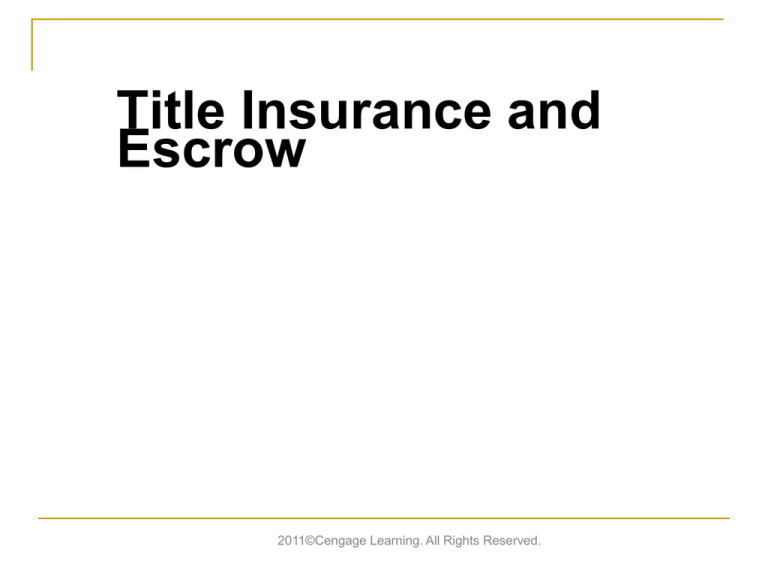
Title Insurance and
Escrow
2011©Cengage Learning. All Rights Reserved.
NATURE OF TITLE INSURANCE
Insures that title to real estate is free from
defects in title, undisclosed liens, and
adverse claims.
The title company agrees to pay any covered
loss up to the face amount of the policy
2011©Cengage Learning. All Rights
Reserved.
Title insurance is Legally Optional.
2011©Cengage Learning. All Rights
Reserved.
TITLE INSURANCE
Title companies are regulated by the
insurance commissioner.
Title insurance involves only one premium,
payable at close of escrow.
Title insurance has become essential and
customary in most California real estate
transactions.
2011©Cengage Learning. All Rights
Reserved.
TYPES OF TITLE POLICIES
The homeowner’s policy (CLTA)
The lender’s policy (ALTA)
2011©Cengage Learning. All Rights
Reserved.
Other Types of Policies
Preliminary title report
Foreclosure guarantee reports
Litigation guarantee reports
Name run reports
ALTA-Residential policy
2011©Cengage Learning. All Rights
Reserved.
Elements of a Policy
Title page
Schedule A
Schedule B
Schedule C
Conditions and Stipulations
2011©Cengage Learning. All Rights
Reserved.
California Land Title Association Policy is
designed to cover the risks commonly
demanded by homeowners.
2011©Cengage Learning. All Rights
Reserved.
ESCROW AND ESCROW
COMPANIES
The seller entrusts the deed and other
documents to the escrow agent.
The buyer deposits all funds and instruments
necessary for the purchase of the property.
The escrow agent collects the data for
documents, prepares instruments for
signature, makes prorations, and arranges for
title insurance.
2011©Cengage Learning. All Rights
Reserved.
Regulation of Escrow
Escrows must be licensed escrow
corporations, having specified monetary
reserves, and bound by strict regulations
under the escrow law.
2011©Cengage Learning. All Rights
Reserved.
ESCROW IS A DOUBLE AGENT
Dual Agency
Limited Agency
2011©Cengage Learning. All Rights
Reserved.
Elements of an Escrow
Valid Contract
Form of Contract
Escrow Instructions Prevail over Earlier
Contract
Delivery, Title, and Risk
2011©Cengage Learning. All Rights
Reserved.
REAL ESTATE SETTLEMENT
PROCEDURES ACT
A broad act that among its provisions
(1) Simplifies the wording of settlement cost
statements
(2) Requires borrowers to be given a good faith
estimate of the costs
(3) Prohibits kickbacks on others disallowed
fees
2011©Cengage Learning. All Rights
Reserved.
Good Faith Estimate Form
Lenders must use the standardized Good
Faith Estimate HUD form
See text
page 527
2011©Cengage Learning. All Rights
Reserved.
2011©Cengage Learning. All Rights
Reserved.
Limits On Good Faith Estimate
Increase
Three categories of good faith estimates
First category represents settlement values
that cannot change from the GFE
Second category limits any settlement values
from exceeding 10% more than the GFE
unless there are “changed circumstances
Final category includes all other costs, and
these can vary without limit
2011©Cengage Learning. All Rights
Reserved.
Limits
First category includes items totally under a
lender’s control such as lender’s origination
fees, points, and transfer taxes
2011©Cengage Learning. All Rights
Reserved.
Limits
Second category includes all other lenderrequired services, title insurance policy and
government recording charges.
2011©Cengage Learning. All Rights
Reserved.
Limits
Final category examples include title
insurance policy costs not identified by name
on the GFE, services chosen by the borrower
such as homeowners insurance, and daily
interest costs.
2011©Cengage Learning. All Rights
Reserved.
When the limits are exceeded
and this error is brought to the
lender’s attention, the lender
must reimburse all excess charges.
2011©Cengage Learning. All Rights
Reserved.




